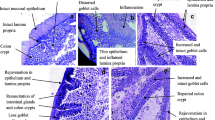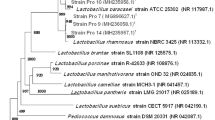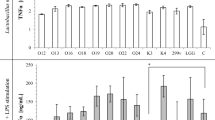Abstract
Six strains of lactobacilli belonging to three species (Lactobacillus casei, Lactobacillus acidophilus and Lactobacillus helveticus) were evaluated for probiotic attributes viz. acid tolerance, bile tolerance and cell surface hydrophobicity. All the six strains exhibited probiotic attributes with considerable degree of variation. Three Lactobacillus strains selected on the basis of probiotic attributes were used for preparing three different fermented milks. In order to evaluate the effect of feeding these probiotic fermented milks on macrophage cell function, an in-vivo trial was conducted in mice for a period of 2, 5 and 8 days. The control group of mice was fed with skim milk. The phagocytic activity of macrophages increased significantly (P < 0.05) on feeding fermented milk prepared using L. acidophilus, L. casei and L. helveticus as compared to milk group (control) on 2nd, 5th and 8th day of feeding, respectively. Likewise, the release of β-glucuronidase and β-galactosidase from peritoneal macrophages increased significantly (P < 0.05) on 2nd, 5th and 8th day of feeding as compared to their respective control group (milk). The results thus depict that feeding of probiotic fermented milk enhances phagocytic activity of the macrophages.





Similar content being viewed by others
References
Schaffsma G (1996) State of the art concerning probiotic strains in milk products. IDF Nutr Newsl 5:23–24
Reid G, Jass J, Sebulsky MT, McCormick JK (2003) Potential uses of probiotics inclinical practice. Clin Microbiol Rev 16:658–672
Gill HS, Guarner F (2004) Probiotics and human health: a clinical perspective. Postgrad Med J 80:516–526
Mercenier A, Pavan S, Pot B (2003) Probiotics as biotherapeutic agents: present knowledge and future prospects. Curr Pharm Des 8:99–110
Shanahan F (2003) Probiotics in inflammatory bowel disease: therapeutic rationale and role. Adv Drug Deliv Rev 56:809–818
Stanton C, Gardiner G, Meehan H, Collins K, Fitzgerald G, Lynch PB, Ross RP (2001) Market potential for probiotics. Am J Clin Nutr 73(Suppl.):476S–483S
Naidu AS et al (1999) Probiotic spectra of lactic acid bacteria. Crit Rev Food Sci Nutr 39(1):13–126
Galdenao MC, Perdigon G (2006) The probiotic bacterium Lactobacillus casei induces activation of the gut immune system through innate immunity. Clin Vaccine Immunol 13:219–226
Dunne C, Mahony LO, Murphy L, Thorton G, Morrissey D, Halloran SO, Feeney M, Flynn S, Fitzgerald G, Daly C, Kiely B, GCO’ Sullivan, Shanahan F, Collins JK (2001) In vitro selection criteria for probiotic bacteria of human origin: correlation with in vivo findings. Am J Clin Nutr 73:386S–392S
Tuomola E, Crittenden R, Playne M, Isolauri E, Salminen S (2001) Quality assurance criteria for probiotic bacteria. Am J Clin Nutr 73:393S–398S
Clark PA, Cotton LN, Martin JH (1997) Selection of bifidobacteria for use as delivery adjuncts in cultured dairy foods. II. Tolerance to stimulated pH of human stomachs. Cul Dairy Prod J 28(4):11–14
Gilliland SE, Staley TE, Bush LJ (1984) Importance of bile tolerance of Lactobacillus acidophilus used as dietary adjunct. J Dairy Sci 67:3045–3051
Rosenberg M, Gutnick D, Rosenberg E (1980) Adherence of bacteria to hydrocarbons: a simple method for measuring cell-surface hydrophobicity. FEMS Microbiol Lett 9:29–33
Stossel TP (1980) Phagocytosis. In: Rose N, Friedman H (eds) Manual of clinical immunology, 2nd edn. Am Soc Microbiol 313
Conchie J, Findlay J, Levy J (1959) Mammalian glycosidase distribution in the body. Biochem J 71:318–325
Hay FC, Westwood OMR (2002) Phagocytosis, complement, antibody-dependent cytotoxicity. In: Hay FC and Westwood OMR (eds) Practical immunology. Blackwell Science, London, pp 203–205
Martini MC, Bolweg GL, Levitt MD, Savaiano DA (1987) Lactose digestion by yoghurt β-galactosidase. Influence of pH and microbial cell integrity. Am J Clin Nutr 45:432–437
Jacobsen CN, Rosenfeldt NV, Hayford AE, Moller PL, Michaeken KF, Paerragaard A, Sandstrom B, Tvede M, Jakobsen M (1999) Screening of probiotic activities of forty seven strains of Lactobacillus spp. by in vitro techniques and evaluation of colonization ability of five selected strains in human. Appl Environ Microbiol 65:4949–4956
Mishra V, Prasad DN (2005) Application of in vitro methods for selection of Lactobacillus casei strains as potential probiotics. Int J Food Microbiol 103:109–115
Morata De Ambrosini V, Gonzalez S, Pesce De Ruiz Holgando A, Oliver G (1998) Study of morphology of cell walls of some strains of lactic acid bacteria and related species. J Food Prot 61:557–562
Perdigon D, de Macias Alvarez S, Oliver G, de Ruiz Holgado AP (1986) Lactobacilli administered orally induce release of enzyme from peritoneal macrophages in mice. Milchwissenschaft 41:344–348
Perdigon D, de Macias Alvarez S, Oliver G, de Ruiz Holgado AP (1986) Effect of perorally administered lactobacilli on macrophage activation in mice. Infect Immunol 53:404–410
Perdigon G, de Macias Alvarez S (1992) Probiotics and the immune state. In: Fuller R (ed) Probiotics. Chapman & Hall, London, pp 146–176
Kapila S, Sinha PR, Singh S (2007) Influence of feeding fermented milk and non-fermented milk containing Lactobacillus casei on immune response in mice. Food Agril Immunol 18:75–82
Schynder J, Bagglioini M (1978) Secretion of lysosomal hydrolases by stimulated and non stimulated macrophages. J Exp Med 148:435–450
Acknowledgments
The authors acknowledge Dr. V. K. Kansal, ExPrincipal Scientist, NDRI for providing L. acidophilus VK2 strain. The financial aid to carry out this study by Department of Biotechnology (DBT), Government of India, is fully acknowledged.
Author information
Authors and Affiliations
Corresponding author
Rights and permissions
About this article
Cite this article
Kapila, R., Kapila, S., Kapasiya, M. et al. Comparative Evaluation of Oral Administration of Probiotic Lactobacilli-fermented Milks on Macrophage Function. Probiotics & Antimicro. Prot. 4, 173–179 (2012). https://doi.org/10.1007/s12602-012-9107-x
Published:
Issue Date:
DOI: https://doi.org/10.1007/s12602-012-9107-x




